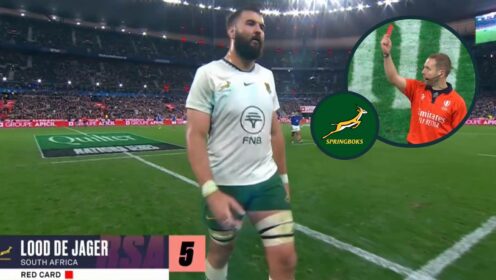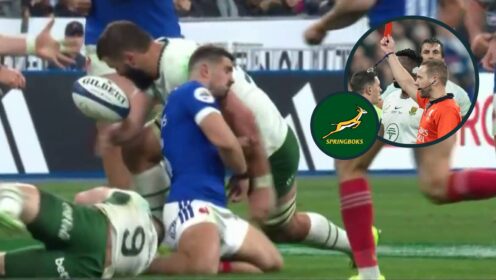Loose Pass: Why Lood de Jager defenders are ‘missing the point’ while Thomas Ramos takes ‘greatest of all time’ tag

Springboks lock Lood de Jager was red carded against France.
This week we will mostly be concerning ourselves with the roll call of tough decisions, lightning striking twice and one of the all-time great individual moments…
The nuances
What do Lood de Jager, Selestino Ravutaumada, Charlie Lawrence and Jacob Stockdale have in common? Well, if you spent the weekend draped across a sofa soaking up endless rugby as Loose Pass did, you’d know that all three received marching orders of various degrees of severity for dangerous play. And between them, all illustrated perfectly, once again, the devil of the job the numerous officials of rugby matches have when it comes to getting it correct.
Were they all correct? As always, it’s the nuance that some see which the officials ‘inexplicably’ miss – or vice versa – which causes the debate. Fun for us all in our armchairs, probably less so for those who are actually tasked with making the decisions which affect the moods of thousands. Not least when the letter of the law says one thing, yet the individual circumstances make the letter of the law seem nothing more than it is: a bunch of words arranged on a pdf.
Jacob Stockdale was terribly unlucky that the step and duck of Kippei Ishida, not to mention the foot of height difference between the two, did not render his yellow-card tackle a ‘rugby incident’, the counter-argument being that he was more upright (in reality, the general argument is starting to look more and more like the head was upright rather than parallel to the shoulder in a stoop) than he should have been.
Lawrence was also unlucky, perhaps even more so. At first viewing it looked horrible and thoroughly card-worthy, yet slowed down, Lawrence does not lift, it is the momentum of Tom Farrell (and there’s a significant weight and height difference in play here too), as well as the latter’s attempt to shift his hips past the tackle to avoid it, which initially causes the contact point to be unstable. Once Farrell’s upper body had tipped over Lawrence’s shoulder, the potential for danger was high, and with Farrell’s weight moving forward but with Lawrence’s weight chasing the contact point sideways, and Farrell’s forward momentum now stalling, the end body position of Farrell landing head area first was close to unavoidable.
If Stockdale was unlucky, one could at least point to the head position and cite technique, but Lawrence really did not seem to do anything wrong. He dipped, wrapped, hit with the shoulder and held on while trying to drive through the contact. It was very harsh indeed as a yellow, and seemed influenced by the outcome rather than analysis of the process.
Comparable cases in terms of understanding technique, while those of Ravutaumada and De Jager bear comparison in terms of recklessness.
The Fijian winger was at full speed for his entire kick chase, but the age-old defence of ‘he was only watching the ball’ does not hold any more. In an era of increased duty of care, it is incumbent upon those bracing to contest for a high ball to at the very least be aware of who the contestants might be. Ravutaumada showed nothing of this until it was far too late, despite his having a good two or three seconds during the chase to weigh up the situation.
Law discussion: Why the All Blacks try stood but Japan were penalised for nearly identical actions
He was immeasurably fortunate that Immanuel Feyi-Waboso’s body was twisting during his jump for the ball, and that the momentum of this twist ensured that the landing was on the front of the body and not the side, over which he’d have had far less control of the landing. But the challenge was reckless and never legal. He was extremely lucky to only get yellow; on balance, it would appear the decision to keep it at yellow was influenced by the outcome of the tackle rather than the minutiae of the tackle itself.
A similar argument of recklessness applies to De Jager. And with interest. He was heading into a situation in a manner which has explicitly been outlawed and picked up on for years now: shoulder tucked, no wrap, focussed on a player already in the contact point. If you argue that the only reason for head contact was that Thomas Ramos was already at waist-height because he was being tackled, you’re missing the point. The review should focus on process, not outcome. At no time were the challenges of De Jager or Ravutaumada legal, and both should have seen red.
Highs and lows for Wales
There were brief moments. Louis Rees-Zammit’s cameo offered hope. The break by Dan Edwards was scintillating. The line-out was solid. The forwards offered a platform and recycled well at times.
Yet there were spells when the scale of the task facing Steve Tandy was laid starkly out. The restart return that took 24-14 to 31-14 a minute before half-time. The countless offsides. The insipid kicking game.
Most damning were two moments though. Shortly after half-time, Wales ran through around 15 phases of possession with not one line-break nor metre gained. Argentina then turned the ball over and scored within three phases.
And then the saltiest of wound-rubs: exactly the same wrap-around move, intercepted by the Argentina fly-half, that put paid to the World Cup hopes in France two years ago. Same lines, same positions, same outcome.
Reviving Wales is challenge enough, without repeating the mis-steps of yesteryear.
The greatest of all time?
Pablo Matera’s chip for his winger to chase? Henry Arundell’s turn of speed? Damian McKenzie’s finish? Scotland’s comeback?
None of the above. Nothing of the weekend past could be a contender for the GOAT epithet more than the shrug of Ramos when being ticked off by Angus Gardner.
“It’s him…” 😅
Something tells us that Cobus Reinach and Thomas Ramos aren’t on one another’s Christmas card lists 👀 pic.twitter.com/VmpSX6qgX1
— Rugby on TNT Sports (@rugbyontnt) November 8, 2025
Fully three seconds of tight-shouldered, wide-eyed, hands-on-the-hips, vacantly-staring-into-the-distance of feigned indifference before the coiffure was nonchalantly sorted out and the France full-back decided to move on, all serious-like, while all the other nationalities assembled before him enjoyed a good laugh.
A shining example of its genre. Magnifique!



